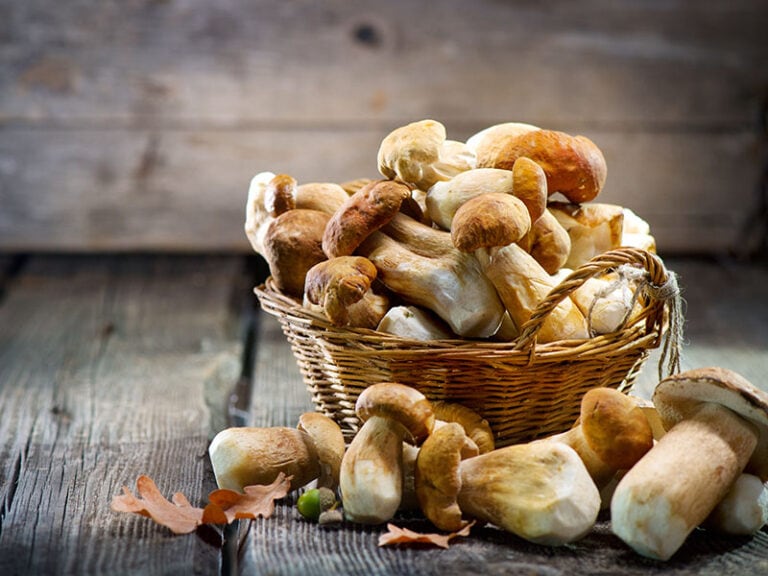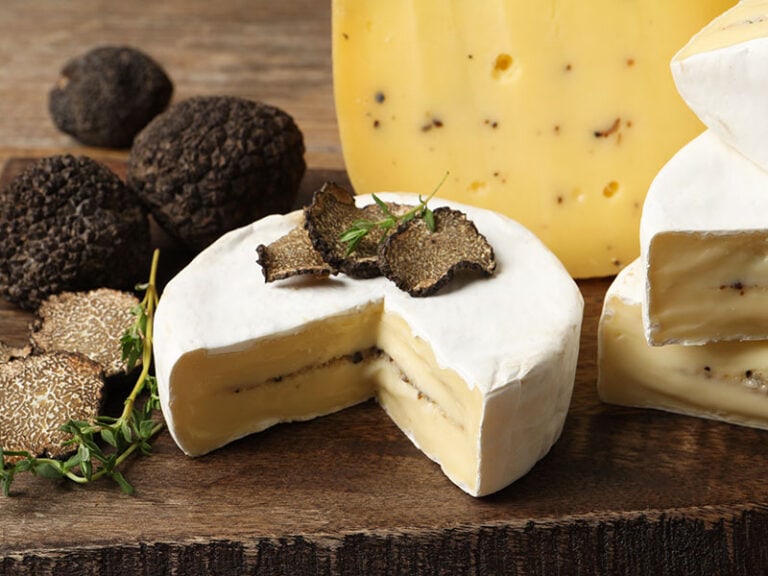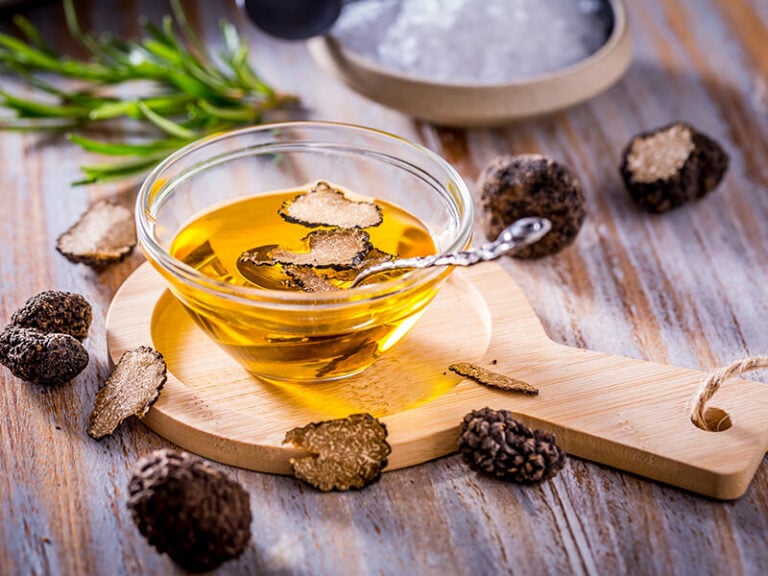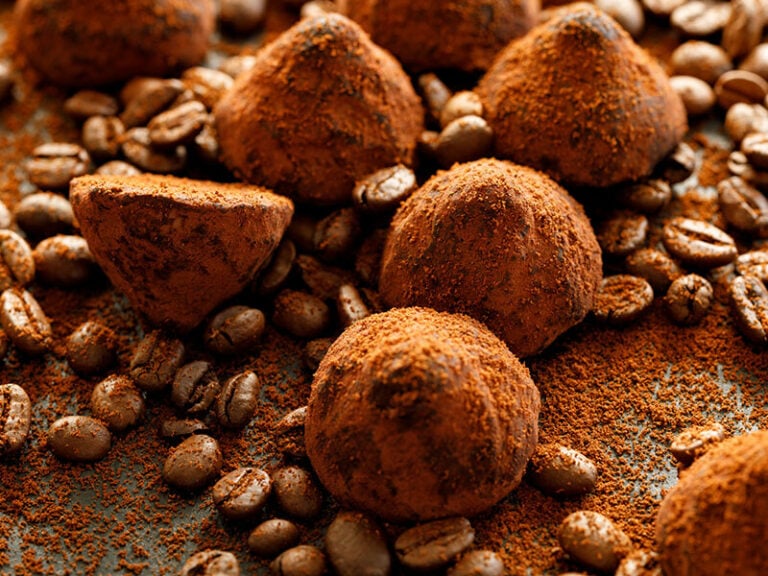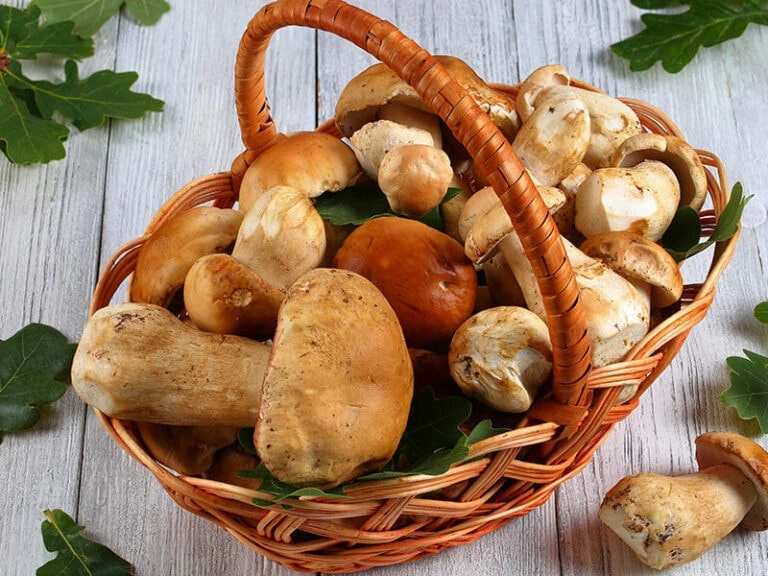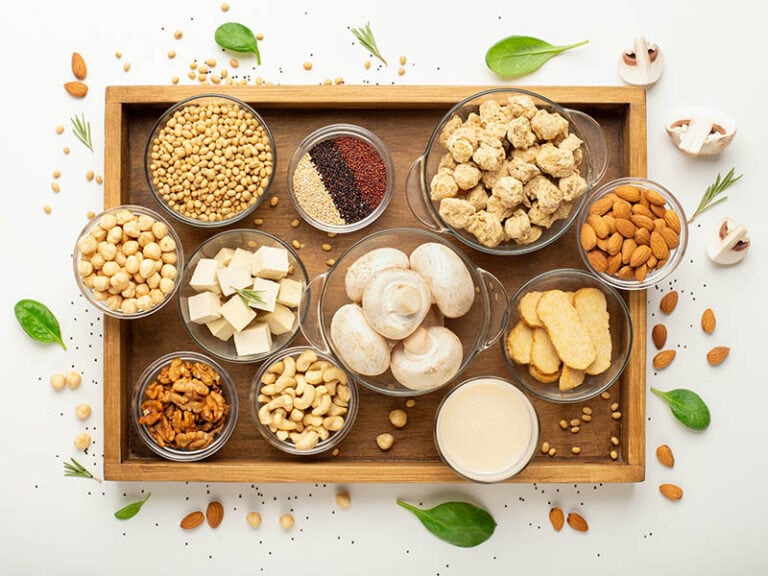“Can you freeze mushrooms?” is a question many people ask. To maximize nutrition and flavor, you should use fresh mushrooms. However, you will not always use up all the mushrooms you have, and freezing seems like the best option in those cases.
In this article, I will show you some features of mushrooms you need to know, how to freeze and defrost them for cooking. Plus, there will also be some mouth-watering recipes near the end of the post, so don’t go anywhere; you won’t regret reading it!
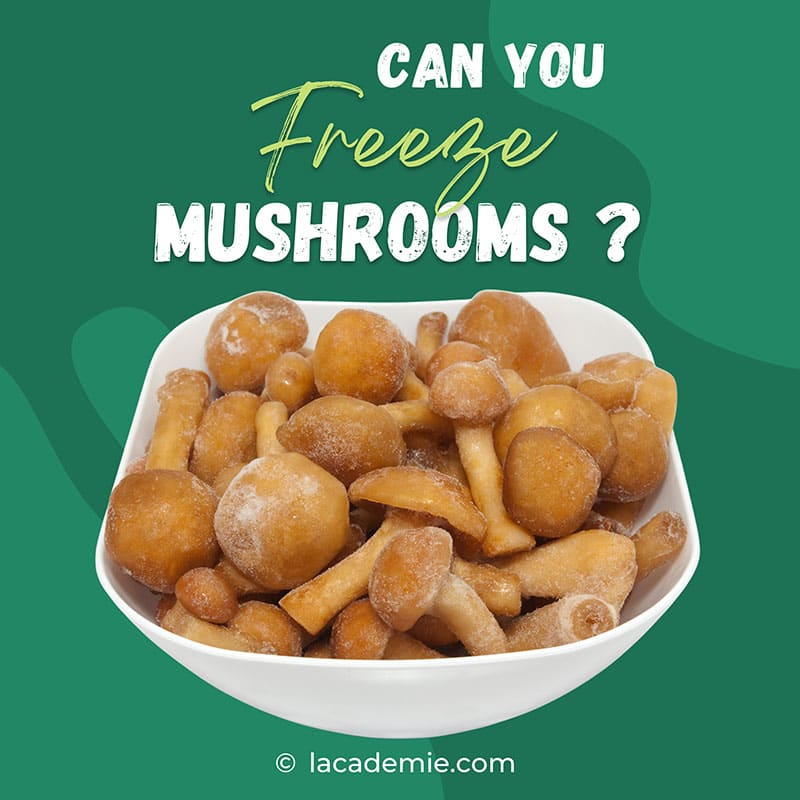
An Overview Of Mushrooms
Mushrooms are greatly consumed because of the benefits they bring. However, do you know some characteristics of them? Let’s go over some of their features that you should know to gain a better understanding.
Types Of Mushrooms
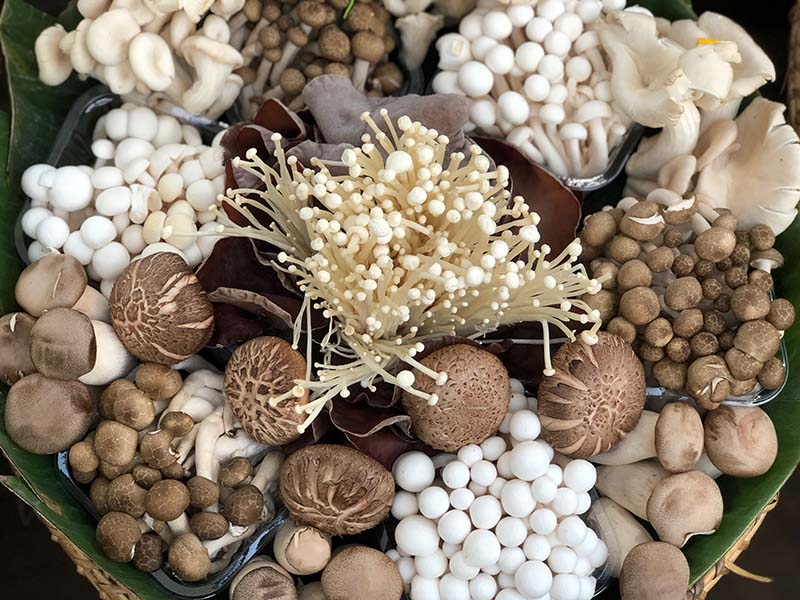
Mushrooms are a popular food around the world. There are 4 main types of mushrooms, including saprotrophs, parasitic, mycorrhizal, and endophytic. Within these categories, some mushrooms are safe to eat, while others might be hallucinogenic or even poisonous.
Saprotrophic mushrooms feed on decaying plants and animals by releasing special acids and enzymes that turn dead tissues into tiny molecules. Prime examples of this group are shiitake – a famous mushroom native to Japan, oysters, white button, and Turkey tail mushrooms.
Parasitic mushrooms form a one-sided relationship with a weaker host and live on its nutrition. Lion’s mane, honey fungus, caterpillar fungus, and Chaga are some remarkable names in this group.
While parasitic mushrooms will eventually kill their hosts, mycorrhizal fungi create a “win-win” bond with plants so that both sides receive something in the end. Porcini, matsutake, and truffle – the world-renowned “King of the kitchen” are great examples.
Last but not least, endophytes are fascinating types of mushrooms whose behavior perplexes even the world’s finest researchers. Although these mushrooms tend to colonize the hosts (just like parasitic fungi), their hosts live still and even benefit from their existence.
More interestingly, unlike mycorrhizal mushrooms, which cease to live without a host, mycologists have successfully cultivated “stand-alone” endophyte fungi.
Don’t forget to equip yourself with useful knowledge about poisonous mushrooms.
The Exquisite Taste Of Mushrooms
Overall, the flavor of mushrooms can be described as earthy and slightly savory, making them an excellent alternative to meat for vegans. However, it would be a big mistake to think that all fungi taste the same.
While the generic mushrooms found at grocery stores might have a similar profile, premium mushrooms such as truffles and Matsutake will surprise you with their incredible taste. I mean, there’s a reason why Matsutake mushrooms are considered “more precious than gold”!
Amazing Health Benefits Of Mushrooms
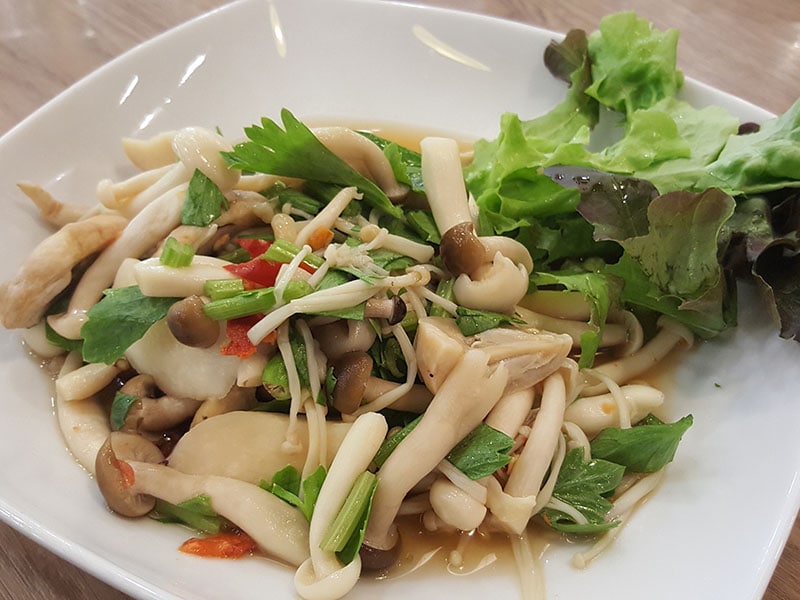
Mushrooms provide you with several important nutrients. Most mushrooms contain the same quantities of nutrients per serving, regardless of their shape or size.
These bad boys are packed with plenty of nutrients such as protein, carbohydrates, fiber, calcium, iron, etc. Besides, they are rich in B vitamins, including B5, B3, B2. In other words, you can think of mushrooms as miniature powerhouses. (1)
Mushrooms also have many health benefits for your skin, brain, and bones. They can help keep you young, protect your brain, improve heart health, strengthen your bones, and give you energy. (2)
Learn about the amazing nutritional content of mushrooms now!
Freeze Your Mushrooms – Yes Or No?
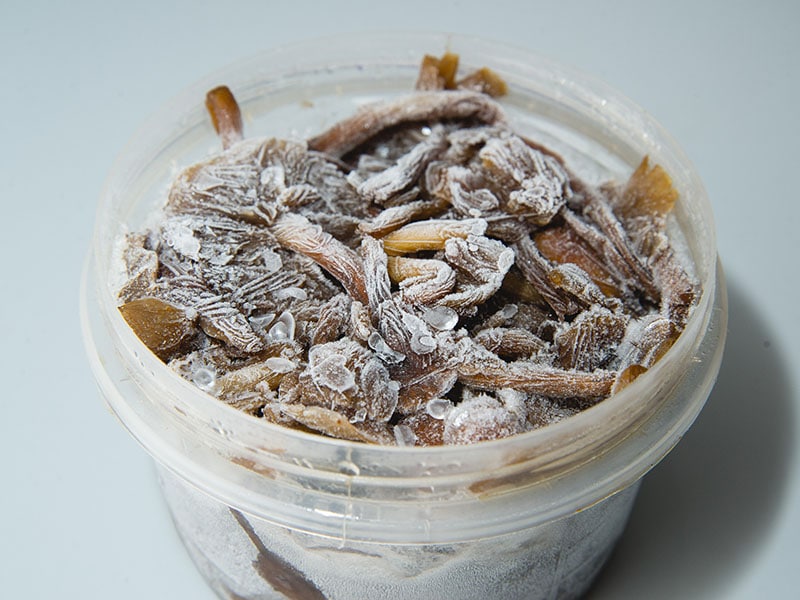
Like many other foods, mushrooms will spoil quickly if not stored well. Fortunately, freezing is an excellent storing method for your beloved fungus. With the help of a freezer, you can keep these delicious treats for even up to a year! How incredible is that!
Although there are several differences between fresh and dried mushrooms, you can freeze them both for long-term storage. Yes, you read it right. You should also freeze-dried mushrooms to protect them from their greatest enemies: heat and moisture.
Although freezing mushrooms can cause them to lose nutrients and change their texture, these side effects are mostly negligible and still allow them to be used in many ways. If you haven’t sold on this method yet, here are some advantages of frozen mushrooms.
More Convenient
Trust me; a bag of frozen mushrooms available at home will make your life much easier and more convenient, especially on days when you’re busy with work.
There’s no need to go grocery shopping, just open your freezer and whip up a delicious meal with some “ready-to-use” mushrooms.
Avoid Food Waste
Freezing mushrooms helps you avoid food waste. Why do I say that? Freezing prolongs the shelf life of mushrooms, so if you have leftovers, freeze them rather than throw them away. It’s always a waste to discard food before its expiry date!
Save Money (On The Long Run)
If you buy a lot of mushrooms and don’t use all of them, try freezing them. Freezing helps prevent spoilage in mushrooms and will save you money in the long run.
The Side Effects Of Freezing Mushrooms
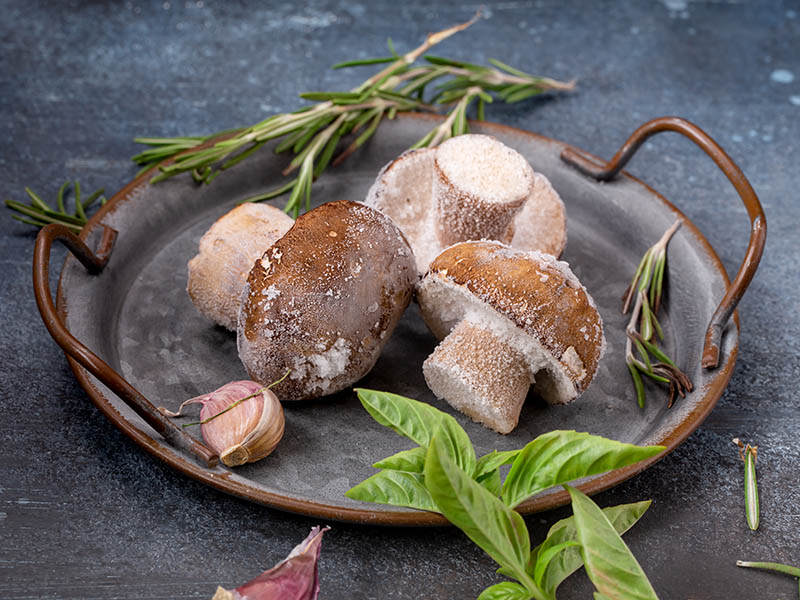
Although you can preserve mushrooms by freezing, this method can negatively affect the quality and the texture of mushrooms.
Mushrooms are high in water content. As a result, frozen mushrooms tend to become mushy after thawing. Now that the texture of the mushrooms has changed, you may not want to use them in some dishes.
In addition, I don’t recommend freezing if you plan to consume your mushrooms without cooking. While some types of raw fungi are edible, frozen mushrooms won’t taste nearly as good as freshly-bought ones.
Lastly, all fresh food loses nutrients over time, and mushrooms are no exception. Although they are an abundant source of nutrients, like many other frozen foods, the nutritional components in mushrooms will fade away during storage.
A Detailed Guide To Freezing Mushrooms
There are many ways to freeze mushrooms. However, depending on the condition and state of the mushrooms, some methods will be better than others. Here are the best methods to keep your precious fungi edible for a long time.
Freeze Raw Mushrooms
When kept in the freezer, fresh mushrooms can turn soft and unappealing because the water molecules inside them freeze into ice and break the cell walls.
However, the following methods will help you preserve the mushrooms’ shape and flavor. They only take a few minutes to prepare yet are incredibly effective.
Freeze Sliced Mushrooms
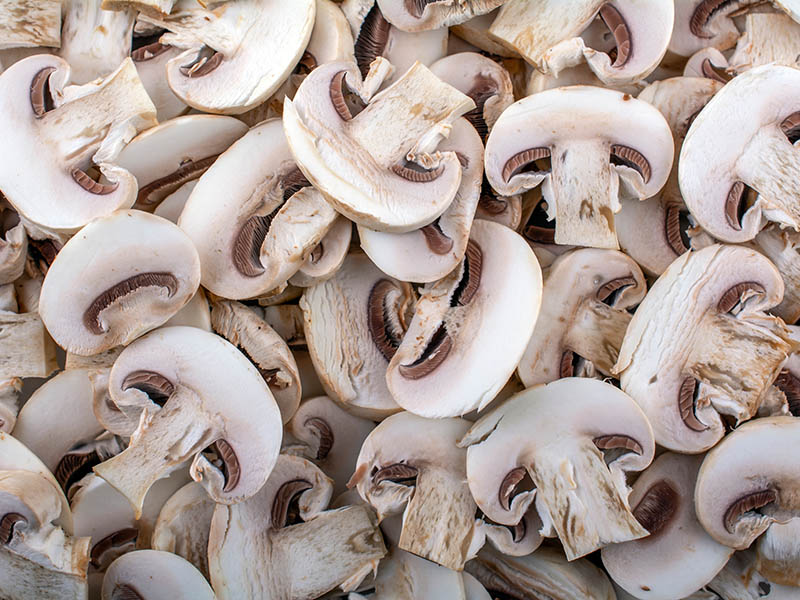
Sliced mushrooms will have a short shelf life if you do not properly store them. Follow these steps to maintain their freshness and nutrients.
Step 1: Clean The Mushrooms
Use a lint-free cloth, paper towel, or mushroom cleaning brush to scrub the dirt.
Alternatively, you can also rinse the mushrooms lightly, then pat dry with a paper towel. However, I do not recommend cleaning the mushrooms this way. And note that you shouldn’t soak the mushrooms because they will become mushy.
Step 2: Dry The Mushrooms And Slice Them
Use a paper towel to dry the washed mushrooms (if you choose to rinse them). Then, slice them thinly.
Step 3: Flash Freeze The Mushrooms
Place the sliced mushrooms on a lined tray. Freeze them until firm. This can take at least 2 hours.
Step 4: Freeze Sliced Mushrooms
Place them in freezer bags or containers with lids and freeze.
An easy-to-follow guide to help you with the freezing process.
Freeze Chopped Mushrooms
If your recipe asks for chopped mushrooms, you can chop them up before transferring them to the freezer. To freeze mushrooms this way, follow the procedure below.
Step 1: Clean The Mushrooms
Repeat the first step above.
Step 2: Dry The Mushrooms And Chop Them
Use a paper towel to dry the remaining water on the mushrooms, then chop them into small pieces depending on the recipes.
Step 3: Flash Freeze The Mushrooms
Repeat the third step above
Step 4: Freeze Chopped Mushrooms
Transfer the mushrooms to containers with lids or freezer bags, then let the freezer do its job.
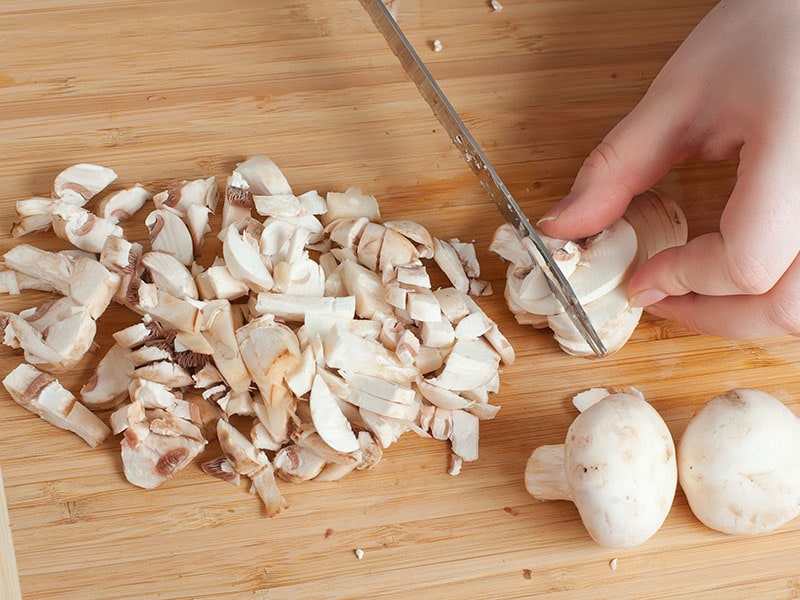
Freeze Cooked Mushrooms
Can you freeze mushrooms after cooking? The answer is yes! This section will show you a couple of simple yet effective freezing methods to keep the mushrooms from spoiling for several months.
Steam Blanching
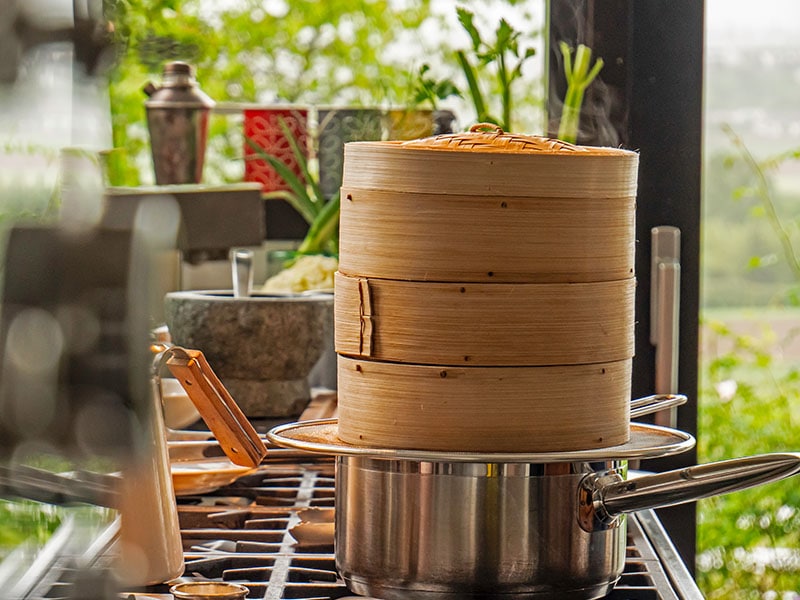
Steaming the mushrooms is the method that preserves the most flavor, keeps the mushrooms from becoming too hard, and can be used in any recipe. With just a few simple steps, you can keep the delicious taste of mushrooms for a year.
Step 1: Prepare The Necessary Ingredients And Tools
Prepare water, lemon juice, a bowl of iced water, kitchen paper, a pot, containers with lids or bags.
Step 2: Clean The Mushrooms
Repeat the first step above.
Step 3: Sort And Chop The Mushrooms (Optional)
Blanching times depend on the size of the mushrooms, so make sure they are similar in size. Then, slice the mushrooms in half or quarters if they are larger than an inch. Do this if the recipe calls for chopped mushrooms.
Step 4: Soak The Mushrooms (Optional)
Add 1 teaspoon lemon juice (5ml) to 2 cups of cold water (480ml), then soak the mushrooms in this mixture for 5-10 minutes to keep the color of mushrooms.
Step 5: Prepare The Steamer
Bring water to a boil with a steamer basket in the pot. If you skipped step 3, you can steam the mushrooms with a mixture of 1 teaspoon of lemon juice and 4 cups of water instead.
Step 6: Steam The Mushrooms
Put the mushrooms in the steamer basket and steam chopped mushrooms for 3-5 minutes and whole mushrooms for 5 minutes. Do not overcook your mushrooms because they will absorb water and become soft.
Step 7: Put The Mushrooms In Iced Water
Put your mushrooms in a bowl of iced water immediately after removing them from the steamer basket. Then wait until the mushrooms are cool enough to touch. This should take roughly the same amount of time as step 5.
Step 8: Wait For The Mushrooms To Drain
After soaking the mushrooms in a bowl of iced water, take them out and arrange them on a kitchen paper-lined tray to dry.
Step 9: Freeze The Mushrooms
Place the mushrooms in containers with lids. You can also use bags, jars, or any other container that can be sealed without breaking at low temperatures. Then date, seal and place them in the freezer.
Still struggling to steam blanch your mushrooms? Here’s a quick instruction!
Sauteing
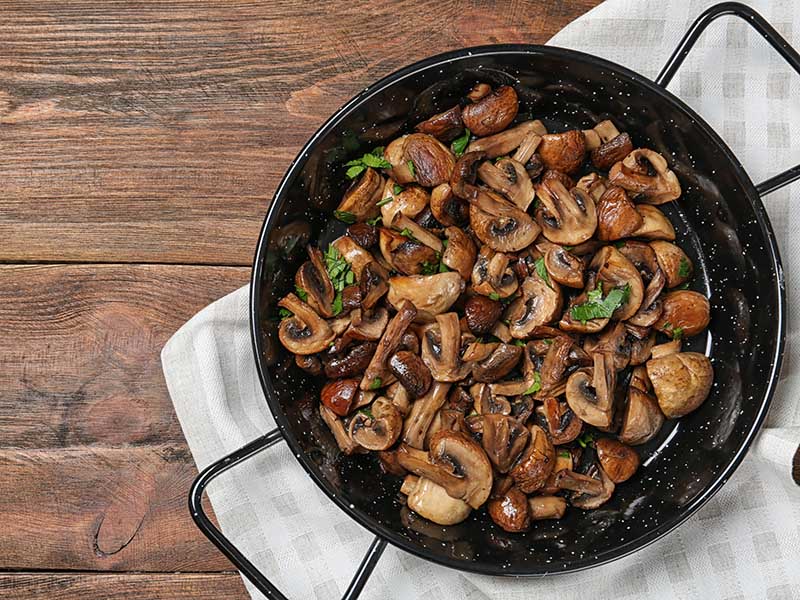
Sauteeing before freezing is no longer a strange method for many people. And you can also apply this before freezing mushrooms to maintain their flavor.
To get the best results from this mushroom freezing way, follow these steps:
Step 1: Prepare The Necessary Ingredients And Tools
Prepare oil or butter, garlic or onion, a pan, a paper towel, containers with lids or bags
Step 2: Clean And Dry Mushrooms
Repeat the first step above. If you clean the mushrooms by rinsing, remember to dry them properly to avoid water splashing out of the pan when the oil is hot.
Step 3: Chop The Mushrooms
You will be sauteing the mushrooms in a pan over medium heat, so thick pieces or whole mushrooms will only be hot on the outside but still raw on the inside. Chop the mushrooms into equal pieces so that the mushrooms are evenly cooked.
Step 4: Heat Oil Or Butter
In a frying pan, heat a small knob of butter or oil. If you want more flavor, you can add minced garlic, onion, or other seasonings to the oil.
Step 5: Cook The Mushrooms
Saute mushrooms in oil until almost cooked. This step will only take 2-4 minutes.
Step 6: Let The Mushrooms Cool
Let the mushrooms cool to room temperature before putting them in the freezer.
Step 7: Freeze Your Mushrooms
Once cooled, place the mushrooms in freezer bags, jars, or any other container with a lid and freeze.
Don’t skip this guide. It’s useful for you to know exactly how to prepare and saute mushrooms.
The Main Differences Between Methods
This section will give you a better overview of mushroom freezing methods so that you can choose the right freezing method for your family.
There are different mushroom freezing methods for different uses of mushrooms. Therefore, it is not possible to determine which method is the best.
However, you should use frozen fresh mushrooms in stews, casseroles, or soups. Because fresh mushrooms are mostly water, they usually become mushy when frozen. As a result, they are not suitable for you to cook stir-fries.
Sauteing or steam blanching mushrooms before freezing will take more time. But you will be able to use them more flexibly and cook them in many ways.
Note that each type of mushroom has a different freezing method. Some types of store-bought mushrooms can be frozen raw or cooked, such as Cremini mushrooms, Button or Portobello.
However, Maitake mushrooms, Hen Of The Woods mushrooms, and wild mushrooms should be frozen raw because they are hard to dehydrate.
How To Thaw Frozen Mushrooms
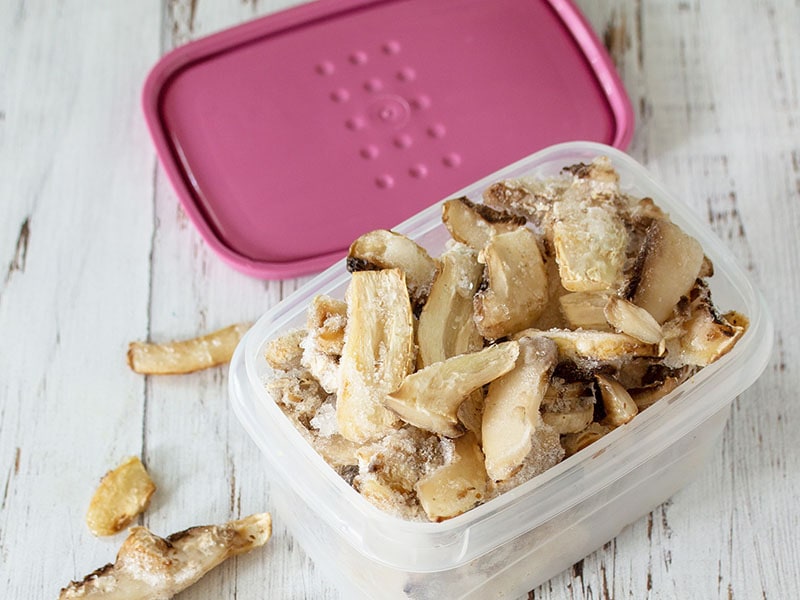
After a period of storing food in the freezer, you will need to thaw mushrooms to be able to use them. But, what is the easiest way to defrost them without losing nutrients?
The process of thawing mushrooms depends on the type of dish you are making. Here are some effective ways to thaw frozen mushrooms
Defrost Using The Refrigerator Compartment
This method is very simple. You just need to take the mushrooms out of the freezer and put them in the refrigerator compartment until they are completely thawed. Normally, this will take about 6 to 7 hours.
With this method, you can keep the mushrooms for another 1-2 days and still maintain their quality.
Defrost Using The Microwave
This is the fastest and most convenient way. You just need to put the mushrooms in the microwave, set the appropriate time (usually no more than 3 minutes), and then press the defrost button.
Note that you should use them immediately when thawing mushrooms this way. Since the mushrooms are warmed and cooked during the thawing process, they can be easily invaded by bacteria or damaged if not used right away.
Soak The Mushroom Bag In Cold Water
This is a quick way to thaw mushrooms without having to defrost them overnight in the refrigerator. With this method, you just need to soak the mushroom bags in cold water.
Change the water after every 15 to 20 minutes or when the water begins to get colder. It will take you about 2 hours to defrost the mushrooms.
Note that you should not tear the bag as air and water will enter the food, making the mushrooms watery and bacteria easier to penetrate. After defrosting them, you should cook them immediately.
Add Frozen Mushrooms Directly To Recipes
You can add frozen mushrooms directly to dishes that will be cooked, such as casseroles, stews, soups, or pizza. Because mushrooms are high in water content, they won’t be an issue when adding directly to those dishes.
Besides, you can also add frozen mushrooms to pasta, rice, or grains while boiling and cooking.
How To Tell If Mushrooms Are Bad
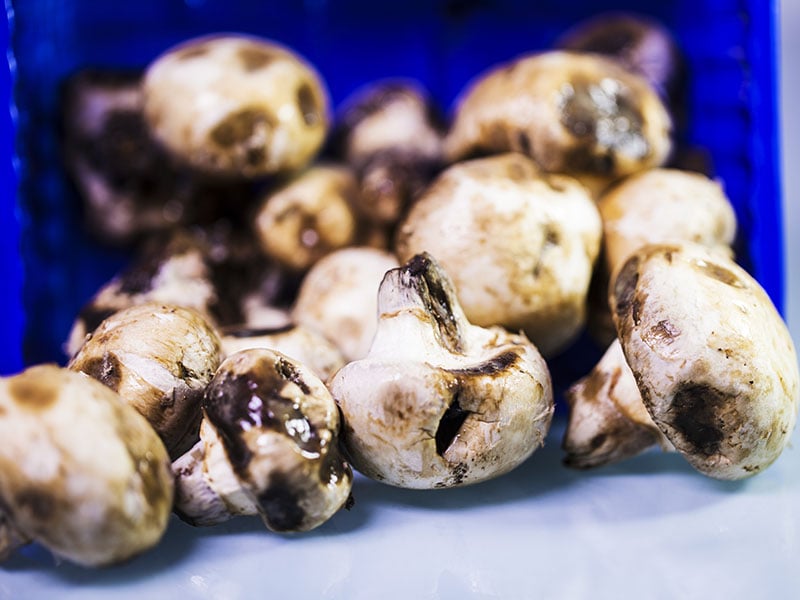
Knowing how to spot a bad mushroom can help you avoid food poisoning. Fortunately, detecting a damaged mushroom is not difficult. When checking, there are a few things that you should look for. Here are some characteristics of bad mushrooms.
Wrinkles And Shrink
Fresh mushrooms come with smooth and plump skin. If you notice wrinkles forming around the mushrooms, that is a sign that they are starting to deteriorate, so use them immediately. If your mushrooms are too wrinkled and shriveled, you should throw them away.
Dark Spots / Darker In Color
Once you spot black spots on mushrooms, it’s a sign that your mushrooms are starting to go wrong. If there aren’t too many dark spots or the spots are small, you can still use them. However, they won’t last much longer.
Besides dark spots, mushrooms also become darker when they begin to get worse. You will have a few days before they are completely spoiled.
Strong Smell
Spoiled mushrooms will give off a terrible smell that your nose will not be able to ignore. By that point, you’d better off finding an alternative to mushrooms for your recipes. If you open the bag of mushrooms and there is a rotten smell coming out, don’t hesitate to throw the bag away.
Sticky Skin
One sign that your mushrooms are not good to eat is slimy skin. If your mushrooms are too slimy, throw them out as they may already be full of bacteria.
Softness and Sponginess
Fresh mushrooms are never soft or spongy. If you feel the mushrooms have such signs, they have begun to decompose, and you should not eat them.
Mold
Mold is the enemy of all foods, and mushrooms are no exception. When mushrooms stay in a moist environment for too long, they will become moldy. Obviously, it’s not good for your health if you eat moldy mushrooms.
Delicious Recipes With Mushrooms
I’ll let you in on some tasty recipes with mushrooms in this section. You can refer to them to prepare delicious dishes for your family.
Portobello Mushroom And Red Pepper Pizza
A pizza with portobello mushrooms and red pepper is a great choice for a two-person dinner. It’s even better with a salad plate. When eating, stir some pesto into the peppers and mushrooms before putting them on the pizza.
Burgundy Mushrooms
Burgundy mushrooms are an easy side dish and packed full of flavor. These mushrooms are delicious with turkey, filet mignon, and beef tenderloin. Plus, burgundy mushrooms are a perfect accompaniment to your Christmas dinner.
Creamy Mushroom Pork Tenderloin
Creamy Mushroom Pork Tenderloin is a simple dish that you can easily prepare in just 30 minutes. This is a dish that’s good enough, quick enough, and full of flavor for busy dinners or any occasion.
FAQs
In this section, you will find the answers to some of the most commonly asked questions about freezing mushrooms on the Internet. Don’t miss out!
An Opportunity For You To Enjoy Dishes With Mushrooms
Well, that is all you need to know about how to freeze mushrooms. From now on, if you want to enjoy excellent dishes with mushrooms, you can save time going to the market if you freeze them at home.
Finally, if you think these storing methods are useful, please spread this information to everyone around so they know how to freeze mushrooms properly. Thanks for reading, and have a nice day!
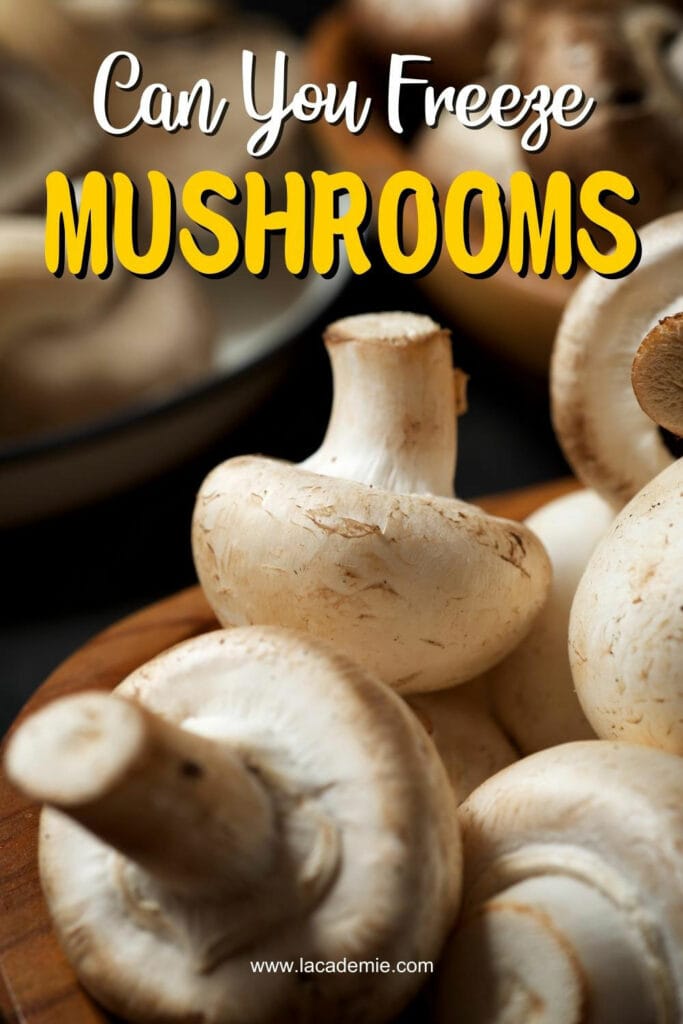
References
- D, M. W. R. L., (2019). Mushrooms: Nutritional value and health benefits
- Goldman, R., (2016). Are Mushrooms Good for You?

